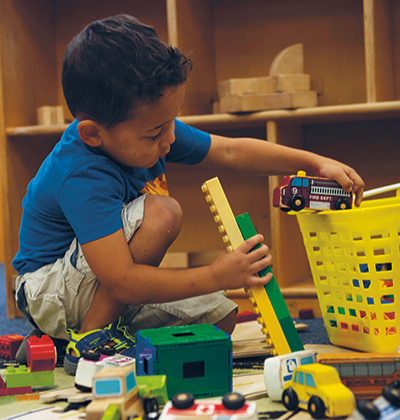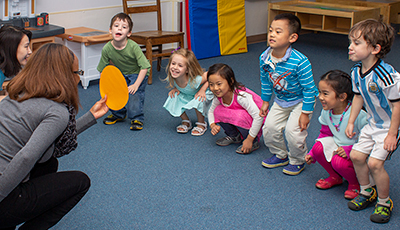Getting an Early Start on Success
Purdue researchers create an early care and education curriculum for the Department of Defense to better prepare children for school and life success
Story by William Meiners, U.S. Air Force photo by Airman 1st Class Christina Bennett
Preschool sets the foundation and tone for a child’s education experience. Research shows that 5-year-olds considered “school ready” are indeed more successful throughout the long run of their academic careers. And while the definition of school readiness may not be the same for every child, Purdue researchers are hoping to maximize lifelong success for as many children as possible. To that end, they answered a call from the Department of Defense (DOD) to develop an early childhood care and education curriculum for use throughout the United States and on military installations all over the world.
Operating the world’s largest employer-sponsored child care system, the DOD serves more than 200,000 children and their families. That scale alone dictates that the curriculum must be both inspiring to children and helpful to a wide range of teachers — from caregivers with minimal classroom experience to 20-year early childhood professionals with advanced degrees.
Led by Douglas Powell, a distinguished professor in the Department of Human Development and Family Studies (HDFS), a Purdue team loaded with experts in the various aspects of early care and education set forth to develop a comprehensive curriculum focused on school readiness. Their outcome: Early Learning Matters, or ELM. In 2016-2017, the team worked closely with child development centers that piloted curriculum resources at eight Air Force, Army, and Marine Corps installations from Virginia to Alaska. Incorporating feedback from teachers and staff using the new curriculum, they have revised and reworked it for global delivery in fall 2019.
Plug and play curriculum
Powell believes early care and education providers will be enthusiastic about using ELM as a research-based, university developed program reflective of how best to support children’s learning. To that end, ELM provides nearly a year of developmentally appropriate activity plans for children organized by ages: birth to 1 year, 1-2 years, 2-3 years and 3-5 years.
 U.S. Air Force photos by Staff Sgt. Jessica H. Smith
U.S. Air Force photos by Staff Sgt. Jessica H. Smith
Working alongside early childhood education experts and researchers across campus, Powell tapped content specialists to provide curriculum roadmaps. Among those HDFS experts, Jim Elicker, Sara Schmitt, Megan Purcell and David Purpura developed subsets of ELM that cater to infant-toddler development, self-regulation, creative expression and mathematics, respectively.
“They offered the big framework in their content areas,” says Powell. “They then suggested specific sequenced activities to use with the roadmap, pointing us to valuable resources that complemented their extensive expertise. A huge advance of ELM is the developmental sequence of activities. Our content experts also reviewed drafts of activities and provided guidance on revisions made in response to feedback from pilot sites.”
The detailed 50-week curriculum supports teachers in becoming experts in adapting detailed activity plans that reflect the latest research and best practices for specific children, Powell says. Furthermore, with so much of the curriculum meticulously spelled out in developmental sequence, younger teachers can use it as a professional development tool.
Kathy Broniarczyk, senior director of outreach and operations for MFRI, knows well the uphill battles of building successful early childhood programs. Part of a military family herself, she has worked in early childhood education for more than two decades, including a seven-year stint overseas as a program director and trainer.
“One of the challenges of military child care, especially overseas, is that staff may not have much knowledge of early childhood development,” Broniarczyk says. “So, having them develop activities to lead children toward learning goals can be difficult.”
Freedom from excessive planning lets teachers zero in on the real-time moments with their children, allowing for deeper dives, such as how language intertwines with early math skills. “As a director or trainer, now I can have my staff really focus on the activities,” Broniarczyk says. “How do you tailor it for this particular child? How do you make it more challenging for these children over here?”
 Photo by Lisa Stein
Photo by Lisa Stein
Broniarczyk, who helped write some of the curriculum and visited and worked with two pilot programs in Virginia and Texas, noted breakthroughs in language and literacy skills that helped to further engage parents who were surprised about hearing words like “frustration” from their kids. “This is not a curriculum where you need to know 12 words before you move on to the next thing,” she says. “There’s a lot of language over many weeks about identifying feelings. It’s very easy for children to understand being happy, sad or mad. But what about frustration? Or embarrassment? Children start understanding these emotions and share that new knowledge with their parents.”
Though military families may face common challenges, including frequent moves, the ELM curriculum is neither military nor geographically based. The DOD leaders anticipate use of ELM systemwide will help families to step into similar programs wherever they are stationed, Powell says.
Tree poses and mindfulness
School readiness means, in part, that a child can keep emotions in check and follow the directions of a teacher. Self-regulation is about expressing emotions appropriately. So, it’s OK to say you’re angry, but not OK to act out that anger by biting another child.
Researchers generally agree on four developmental domains that support school readiness. They include physical, social-emotional, language and cognitive development. Those domains overlap and may not be easily quantifiable. Ideally, a first-grader should be ready to learn by knowing how to listen, explore exciting materials, follow instructions and get along with others.
 U.S. Air Force photo by Staff Sgt. Jessica H. Smith
U.S. Air Force photo by Staff Sgt. Jessica H. Smith
Focusing on social-emotional development, Sara Schmitt, associate professor of human development and family studies, incorporated cutting-edge activities that used mindfulness and yoga in the classroom. In feedback from some of the pilot sites, it seems the yoga was a big hit with the kids.
“The children really enjoyed doing things like tree pose or frog pose,” says Schmitt, who also uses circle games like Red Light-Green Light and other repetitive games that can help children to better think and react in the moment. “But it was also an opportunity for them to focus on their breathing, which can be a strategy for calming down if children experience negative emotions like frustration.”
Age-appropriate meditation, where a child might focus on breathing through a rising teddy bear placed on her belly, could improve self-regulation. For Schmitt, it’s just another aspect of ELM’s intentional focus on the domains linked to school readiness. “The curriculum targets all those early skills that promote academic achievement and does so in an engaging manner,” she says.
“We were all challenged with the question of how to take what we know is good through the research and evidence and put it into the hands of early childhood educators. I do see myself as a bridge for that. ...This gives teachers, who may or may not have a strong background in research and theory, the ability to implement a very strong, research-informed curriculum.”
— Megan Purcell, assistant clinical professor of human development and family studies
Like Schmitt, Megan Purcell, assistant clinical professor of human development and family studies, embraced her own role in helping to craft a large-scale, robust program for the DOD. Powell brought her on board for content development in social studies and creative arts. Purcell also assisted in some of the assessment processes.
“We were all challenged with the question of how to take what we know is good through the research and evidence and put it into the hands of early childhood educators,” Purcell says. “I do see myself as a bridge for that.”
Echoing the praise of her colleagues for a curriculum that allows teachers to better focus on learning in the classroom, Purcell looks forward to its ultimate impact on children. “This gives teachers, who may or may not have a strong background in research and theory, the ability to implement a very strong, research-informed curriculum,” she says.
Military bases to civilian communities
Powell says the DOD has been exceptionally progressive in its move to bolster early childhood education on such a large scale. A comprehensive curriculum, for starters, provides a building block to improve the whole system for children, families and practitioners. The continuity of such services can ease the pain of long-distance moves for families.
But even as a large-scale provider of early childhood care and education programs, not all military children are enrolled in centers on military bases. “DOD centers can enroll a limited number of children,” Powell says. “So, you also have children in community-based programs around the installations, and the DOD would very much like those civilian programs to use the curriculum.”
Shortly on the heels of the ELM curriculum, Purdue established the Center for Early Learning, which is co-directed by Schmitt and Doran French, department head and professor of human development and family studies. Schmitt says this Purdue center is dedicated to improving the quality of early childhood education and care for all children from birth through five by focusing on curriculum, evaluation and research. As a home to interdisciplinary discovery, the center is prime for expansion and evolution through collaborations between researchers and pioneering practitioners.
“The Center for Early Learning will continue to offer support to the DOD as they roll out implementation of the ELM program,” Schmitt says. “It’s exciting because this curriculum fills a substantial gap that exists in the field of early childhood education.”
More Life 360 Stories
Milestones
Students
- Dean’s Message
- Speak Up
- Soccer and Scientists
- A Call to Nursing
- Upgrade
- "What was a GIANT LEAP in your life?"
Faculty
- Dean’s Message
- Speak Up
- Your Friends at Your Fingertips
- Environment for Obesity
- Getting and Early Start on Success
- Beyond 'You are What You Eat'
- Tracking Fat from Digestion to Delivery
- Reducing Obesity and Improving Lives One Community at a Time
- Is Your Drinking Water Safe?
- "What was a GIANT LEAP in your life?"
Alumni
- Dean’s Message
- Breaking the Silence
- A Whole New World
- Grady Eifert
- Giant Leaps Series
- Upgrade
- Hello!
- "What was a GIANT LEAP in your life?"

